 Choosing Lettuce Varieties to Steward
Choosing Lettuce Varieties to Steward
|
|
Create a plan to build your seed collection. Lettuce is a great place to start since it's a super easy plant to save seeds from. Put some time and effort into identifying the varieties that you and your community would like to steward. Below are some videos to help you choose varieties and organize your grow out to ensure you have these varieties for years to come.
|
|
|
| Stewarding Seeds: Lettuce |
|
| Selecting Seeds to Steward |
Here is a
link to the Richmond Grows Seed Lending Library Grow Out Tracking Sheet mentioned in the videos. Here is the
template for the Grow Out Tracking Sheet. If you invite members of your community to grow out lettuce varieties, here is a
lettuce seed saving brochure with some Frequently Asked Questions (FAQs) that you can attach to the seed packet. (The formatting is a bit buggy, but it's meant to have 3 handouts on 1 sheet of paper. Feel free to modify this. If you make improvements, please email them to
[email protected]. We'll happily share them with the community.) It is also helpful to provide hard copies or electronic copies of envelope labels to ensure quality information on donated seeds. This
envelope version is specific to lettuce varieties.
This
Seed Saving Chart is a helpful resource when determining population size, isolation distances, as well as seed viability. You may also want to consider getting varieties that are actively being developed by breeders to continue to select for things that work for you!
If you have strategies or a plan on stewarding seeds, let us know. We'd love to include
your ideas in our next edition of
Cool Beans!
|

Carol Deppe's Beefy Resilient Grex Dry Bean
|
by Elizabeth Johnson, San Luis Obispo, California, USA
SLO Seed Exchange
Every year at the Seed Librarians Summit during the Heirloom Expo, something special happens! In 2017 our esteemed lead librarian, Rebecca Newburn, showed up with a box of seed packets from renowned organic seed breeder and author
Carol Deppe. We all received a packet of about 150 'Beefy Resilient Grex' beans that were in their 5th and 6th generation from an unlikely original volunteer cross between the common Gaucho bean (
Phaseolus vulgaris) and one of my favorite beans, Mitla Black tepary bean (
Phaseolus acutifolius).They are different species and shouldn't cross-pollinate!
Organic seed breeding welcomes these surprises and has been working to expand genetic profiles of common vegetable crops as a counter to
Big Ag's patent push and the loss of diversity in 95% of crop varieties in the last hundred years.
'Grex' is a horticulture term that is now being used by some plant breeders who are expanding the genetic pool by working with hybrids to develop new varieties. The 'Beefy Grex' that Deppe is working with is a part of the Open Source Seed Initiative (OSSI).
In 2015, OSSI crafted a pledge to "free the seed to make sure that the genes in at least some seed can never be locked away from use by intellectual property rights." The OSSI Pledge reads: "You have the freedom to use these OSSI-Pledged seeds in any way you choose. In return, you pledge not to restrict others' use of these seeds or their derivatives by patents or other means, and to include this pledge with any transfer of these seeds or their derivatives."
The OSSI pledge is being taken by some plant breeders, such as Carol Deppe, who choose not to patent but instead offer their work to the public to use as they wish, as long as they don't try to patent that variety or any variety developed using that original variety. The pledge encourages broad experimentation with plant traits selected by a breeder for the benefit of society.
Among organic breeders, there is a lot of interest in landraces, domesticated traditional varieties, that carry more genetic resources than varieties that are strictly controlled to remain the same year after year. From grains to beans to kale to lettuce, interesting new varieties are showing up when allowed to cross-pollinate.
Here is the San Luis Opisbo Seed Exchange's breeding trial for the 'Beefy Resilient Grex' bean.
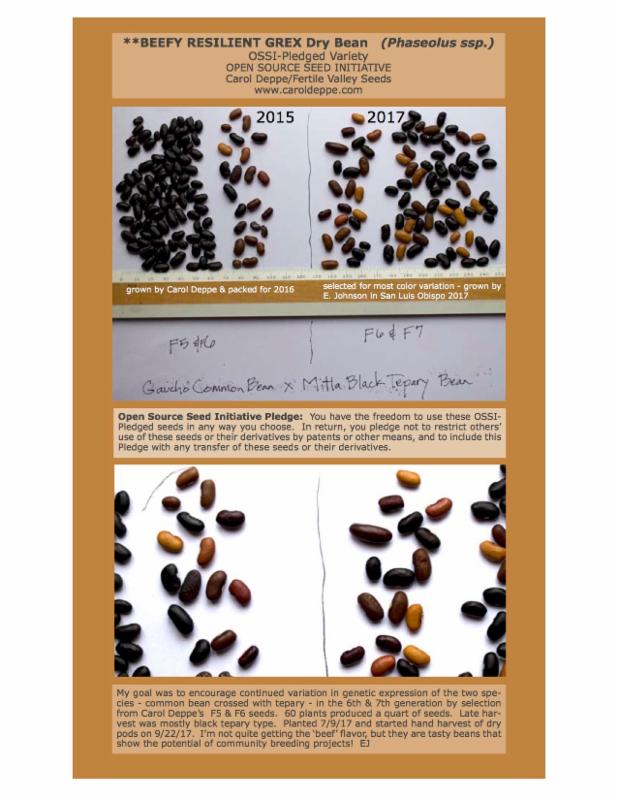
I didn't photograph Carol Deppe's 5th & 6th generation seeds before I planted them in July, so I can't say for sure that there are new or more colors and sizes, and I don't know what she was selecting for every year. I did engage in the concept of community breeding F6 & F7 generations by selecting as many color and size variations as possible for my 60 plant plot in 2017, hoping to see new combinations and differences. I do know that different color and sized pods matured at different times, and after the main harvest the last week of September, the differences were mostly two or three types. Classic Mitla Black tepary outlasted the others.
|
 OSSI Breeders & Companies OSSI Breeders & Companies
|
Interested in supporting biodiversity and seed freedom? Consider buying from companies that have taken the Open Source Seed Initiative (OSSI) pledge. Some varieties are still in the process of being actively selected so you may enjoy helping to create the "heirlooms of the future!" Learn about some of the plant breeders who have taken the OSSI pledge. Support these seedizens* and companies that are making those seeds available.
*Okay, so I made up that word, but I leek it. ;) |
 Featured Seed Library Featured Seed Library
L.P. Fisher Public Seed Library
|

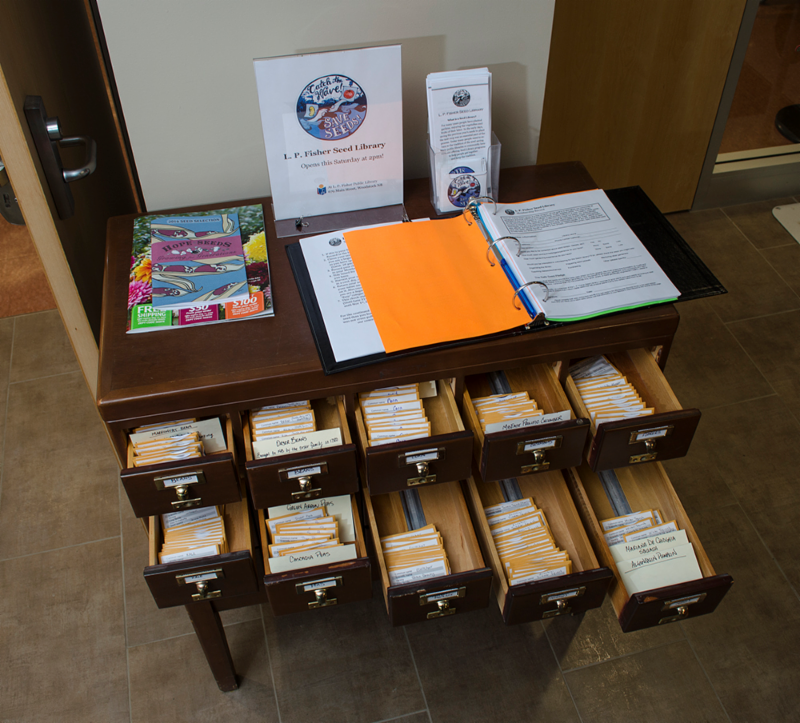 Location:
Location: Woodstock, New Brunswick, Canada
Established: 2016
Number of branches: 1
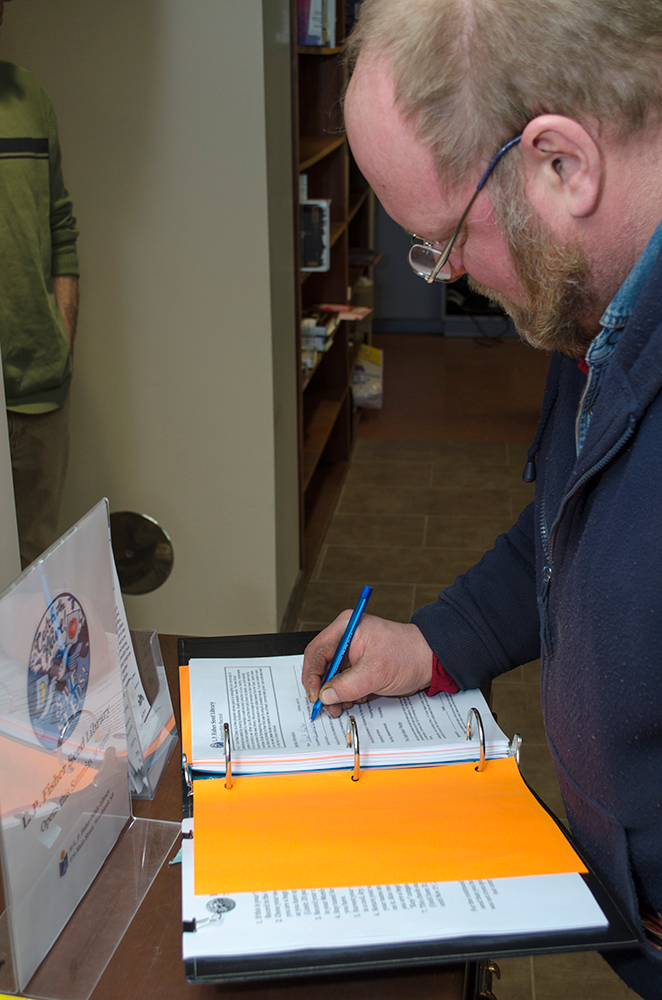 Organizers:
Organizers: Community garden, individual citizens, public librarians, seed savers group
Demographics:
Small town (5200 people) but large rural community, mostly working class. A mixture of Amish and Mennonite and other splinter groups, back-to-the-landers/hip
pies, new urban gardeners (we have a community garden), new immigrants, innovative farmers - some hobby, some commercial.
Reason for opening a library:
An opportunity to share seed, share knowledge, and support the local ecosystem
Words of Wisdom to other seedbrarians:
Have a plan for a solid info management system in place before you begin.
Successes: We now have a wooden seed sorter that patrons can borrow!
Greatest challenge:
Organizing volunteers.
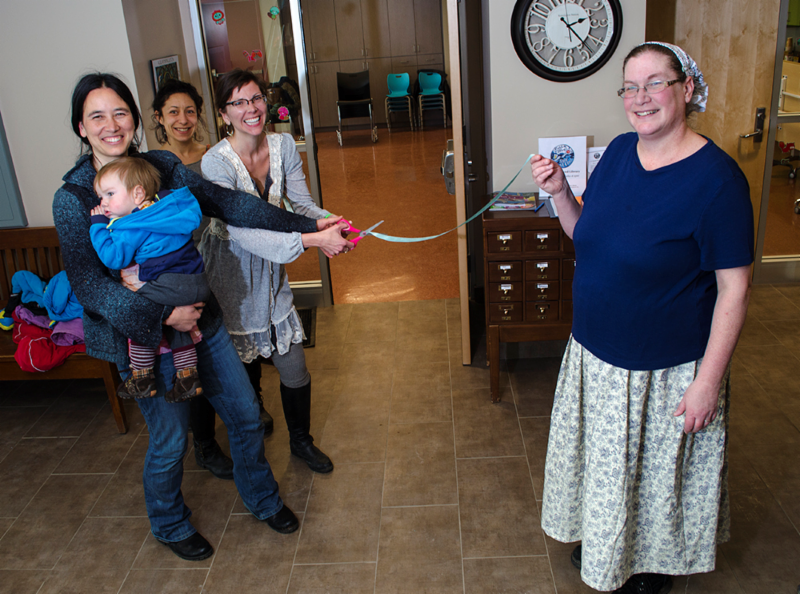
|
 Book Worm Book Worm
Breed Your Own Vegetable Varieties
|
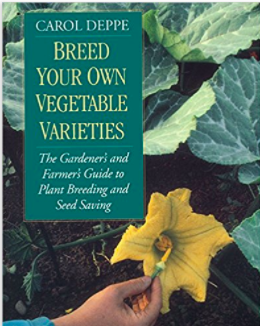
If you've been saving seed, you may want to consider taking it a step further with Breed Your Own Vegetable Varieties by Carol Deppe. The author has a Ph.D. from Harvard in biology,
specializing in genetics. Her writing style is authoritative, yet easy to understand. She uses the straight forward language of a fellow
gardener. There are a couple of technical chapters, but even if you skip over those you will still learn a lot that may tempt you to give plant breeding a try. Her love of gardening and enthusiasm for experimenting with plants shines throughout the book. This book is less about the process of saving seed and more about how to select seeds to get the traits you want. For example, if you want to try to breed a variety of tomato for its sweet flavor you may wait to save
seed at the end of summer when the tomatoes have their absolute sweetest flavor, but in doing so you may have inadvertently selected for late ripening tomatoes too! Deppe relates several stories of backyard gardeners who have developed new varieties of vegetables by blind luck, hard work, or just puttering around. She also explains how it is sometimes possible to 'de-hybridize' a variety so that seed can be saved reliably from year to year. Deppe writes passionately about why we should all breed varieties and save seed. She explains that most new varieties are breed for commercial growers because that's where funding for research is available. But commercial growers want vegetables that have uniform size and shape, tough skin, and hard flesh so they aren't ruined by harvesting machines, long distance shipping, or long times in storage. Ask any backyard gardener and these qualities are rarely what they want in their own vegetables. This book is for gardeners who want more flavorful, bigger, prettier, earlier, hardier vegetables that don't always grow well where you live.
|

Liquid Summer: Alaska in a Bottle
|
 |
|
 |
Rhubarb_ Image_ Wikimedia Commons |
by Deirdre Helfferich,
Growing Ester's Biodiversity Seed Library, Ester, Alaska, USA
Every summer and fall, I pick wild berries: fat black currants, bearberries if I go up to the heights, lightly dusted blueberries, cloudberries when I can get them, crowberries, highbush cranberries, lingonberries, raspberries, rosehips. Sometimes my neighbors have too many domestic berries and invite me to help them pick domestic raspberries, chokecherries, currants, tiny wild strawberries, or, once, golden raspberries. I can almost always find immediate uses for these delicious fruits, usually in the form of pies or liqueurs, or I freeze them for later. Some years are great for harvesting a wild bounty, others not so good. And every year my garden provides a regular supply of Too Much Rhubarb.
Rhubarb, originally from Asia, is a large (very large) member of the buckwheat family, a perennial, and ridiculously easy to grow in Alaska. They like cool weather (they tend to bolt when it gets hot and dry), and I have about ten or eleven crowns in my garden, including one that grew from seed.* The leaves can reach two or even three feet across and the plants three to five feet high (some species can grow even bigger). The stems are what you want to harvest, making sure that you don't take too many at a time so the plant stays strong and sends nutrients down to the deep roots. The roots are orange and woody, and the leaves are green, sometimes turning to bright red in the fall. The stems can be pale green to deep magenta. I never harvest stems for the first couple of years after the rhubarb crowns are planted, to give them time to establish themselves. You can either cut or harvest the stems, but never eat the leaves-the oxalic acid content is high enough to be poisonous. However, they make great mulch or compost pile fodder, and can be used to clean tarnished aluminum (boil the leaves in the pot or pan and the oxalic acid will take care of all those black spots!). (More information on care, cultivars, and so forth is available at the Cooperative Extension Service,
www.rhubarbinfo.com
, Wikipedia, and probably your local gardener friend down the street.)
What to do? I could leave the plants as simple decorative giants in the garden, and often do, but I hate to waste free, fresh food that I grew-especially with so little effort! Give it to the neighbors? They usually seem to have their own excess of rhubarb, too. I don't like the standard solution, strawberry-rhubarb pie (I dislike cooked strawberries, nor do I like rhubarb pie). Both my husband and I find rhubarb pretty tart, and there's really only so much jelly a person can eat. So every year I am faced with the quandary posed by all that rhubarb.
This annual conundrum was solved one year when I was perusing that most wonderful of inventions, the Internet, and came across a recipe for a Rhubarbtini, or a vodka martini with rhubarb juice. That was it! Now, just in case you are assuming that means I got myself snockered every summer thereafter on barrels of vodka martinis, let me assure you that my liver most certainly could not withstand it. What I did do was to harvest the rhubarb stems and juice them. Now I use the juice as a substitute for lemon juice, mixed with other berry juices, frozen as ice cubes, or as a refreshing beverage. Rhubarb is high in fiber, and contains vitamins A and C, thiamin, riboflavin, niacin, potassium, and phosphorus.
Juicing rhubarb is very easy. The tools you need are: a heavy knife for cutting the stems (I have a short, smallish machete that I use for the purpose), a large sharp chef's knife for chopping the stems into quarter-inch or half-inch pieces, a large cutting board, a large steel pot to cook them in, a potato masher or similar, a large wooden spoon, a metal sieve, a funnel, a couple of large glass bowls, lots of decorative bottles with corks or sealable lids (old wine bottles are good), and a few plastic yogurt containers you want to recycle. Harvest your stems, being sure to trim off the leaves and woody ends. The ends toward the base tend to have a lovely rosy or magenta tint that can extend all the way to the leaf. Wash the trimmed stems, and then chop with a very sharp knife on a cutting board. Be careful: the stems can be pretty fibrous and will dull a knife fairly rapidly, so you may have to resharpen it. It's also pretty easy to cut your fingertips, so watch yourself. (I've done it to myself far more often than I like to admit, and not only does it hurt, it's a bit off putting to have human blood as part of the mix, even if it
is
my own.)
Place all the chopped rhubarb into a five-gallon steel pot (smaller or larger depending on how much rhubarb you have) and just cover with water. You can add a bit more water if you like, but keep in mind that it will dilute the juice somewhat. Cover and heat on medium and bring to a simmer. Turn down to low and simmer, stirring occasionally with a wooden spoon, until the chunks are softened, about twenty to thirty minutes. Mash thoroughly. Strain the pulp through a metal sieve into a large bowl (I use a glass or porcelain bowl) and funnel the juice into bottles. Cap tightly and store in the refrigerator. I strain the pulp two or three times, stirring in the sieve to get more juice, but this also increases the amount of small particles in your final product. Since this takes a while, I usually have my first batch of pulp resting in one bowl while the second batch is straining in another. By the time I'm ready to restrain the first batch again, the juice has pooled up around the edges of the mound of pulp and I can pour that off into the next available bottle. Doing this a few times means I get every delicious drop. When you are done straining the pulp, you can store it in the refrigerator for a few days and use it for rhubarb bread, apple-rhubarb sauce, pies, marmalade, or other things, or you can put it in plastic containers and store in the freezer. Be sure to leave a little space between the top of the pulp and the lid, as it will expand slightly when frozen.
Rhubarb juice is a lovely rose pink color, and will deepen in shade depending on the variety. I also like to mix it with blueberry or raspberry juice. Because it is fairly tart, you may want to add sugar to it, although I usually wait until using it later. Unsweetened, it will store in the refrigerator for a couple of weeks, or, like the pulp, you can freeze it for later use, until the winter beckons you to a remembered summer harvest.
*Propagate rhubarb by dividing the crowns in the spring or the fall every four to five years, or when the crown starts producing lots of skinny stalks instead of fewer large stalks. Growing from seed results in a less predictable offspring than splitting a parent plant, rather like potatoes from seed vs. tubers: certainly possible, but you don't know what you'll get.
|
|
Next Issue: Growing Seeds & Community - April 2018
|
 Feedback for this Issue? Ideas for Next Issue? Feedback for this Issue? Ideas for Next Issue?
|
Feedback for Current Issue: Stewarding Seeds
We want to hear from you! Is there a resource we missed around this issue? Do you have a question or idea about topics we discussed here?
Next Issue: Growing Seeds & Community
Our next issue is Growing Seeds & Community and will feature ways to grow community through packing seeds and having a One Seed One Community program. Do you do these? Tips? Do you do other things?
Let us hear from you!
|
|
|

Seed Saving Courses
|
Introduction to Seed Saving
March 24-25, 2018
Tucson, Arizona, USA
$135 for Members, $145 for nonmembers
Native Seeds/SEARCH
Seed School in a Day - Prescott
March 24, 2018
Prescott, AZ, USA
Register
$25, or $15 for Educators &
Slow Food Members
Rocky Mountain Seed Alliance
and Slow Food Prescott
Seed School in a Day - Colorado
March 31, 2018
Hotchkiss, CO, USA
$50
Rocky Mountain Seed Alliance,
Valley Organic Growers
Association, Slow Food Western Slope, and The Learning Council
Seed Seva Seasonal Online Mentorship 2018
April-Nov 2018
Online Seed Stewardship course offered by Rowen White and other seedfolk. Distance learning format.
$35 per month for 8 months
Seed School in a Day, Flagstaff
April 14, 2018
Northern Arizona University in Flagstaff, AZ, USA
$50 or $40 for RMSA Supporting Members
Rocky Mountain Seed Alliance, Northern Arizona University, Northern Arizona Museum, and Flagstaff Foodlink
Seed School Teacher Training
April 22-27, 2018
Denver, CO, USA
$600 for members, $750 nonmembers
Rocky Mountain Seed Alliance,
and Global Seed Savers
Seed School Online
Self-paced, online course
$97
Rocky Mountain Seed Alliance and Urban Farm
Holistic Seed Stewardship Spring Learning Retreat
April 21-22 2018
Sierra Seeds Farm, North San Juan, CA, USA
$150
Sierra Seed
s, Rowen White
Seed School at Sterling College
August 5-10, 2018
Craftsbury Common, VT, USA
$1,250 (includes meals) Open to Sterling College students and general public
Sterling College and Rocky Mountain Seed Alliance
Offering a day long seed saving class?
Cool Beans! and our Facebook page.
|
|
600+ Open!
Sister Seed Libraries
|
- Have you opened?
- Added branches?
- Created a website?
Check the Sister Libraries List to see if your information is accurate and to find other libraries near you. Fill in this survey to help us keep the list accurate.
|
|
Seed Libraries Association
|
- Resources on how to start & manage a seed library
- Sister Seed Libraries pages
- Inspirational projects associated with seed libraries
|
|
Seed Libraries Social Network
|
- Connect with bioregional libraries
- Share ideas with folks with similar projects
|
| Carol Deppe's 'Beefy Grex' -F5 & F6 - Photo by Elizabeth Johnson on SLO Seed Library |
Stay Connected


|
|
 |
|